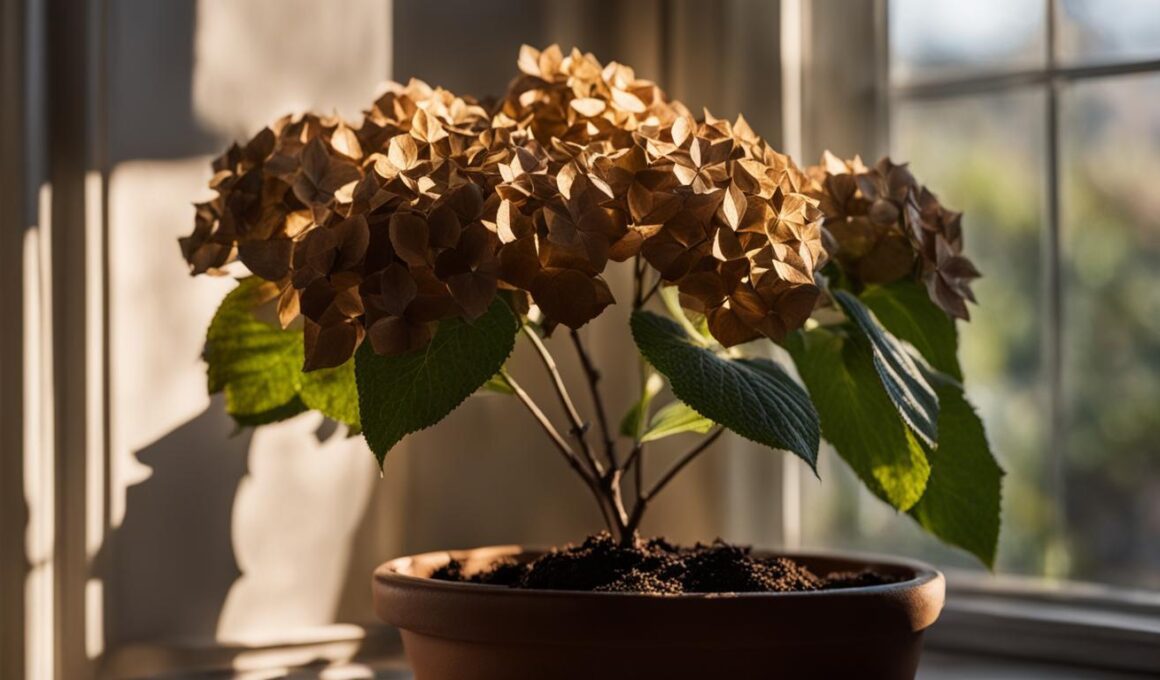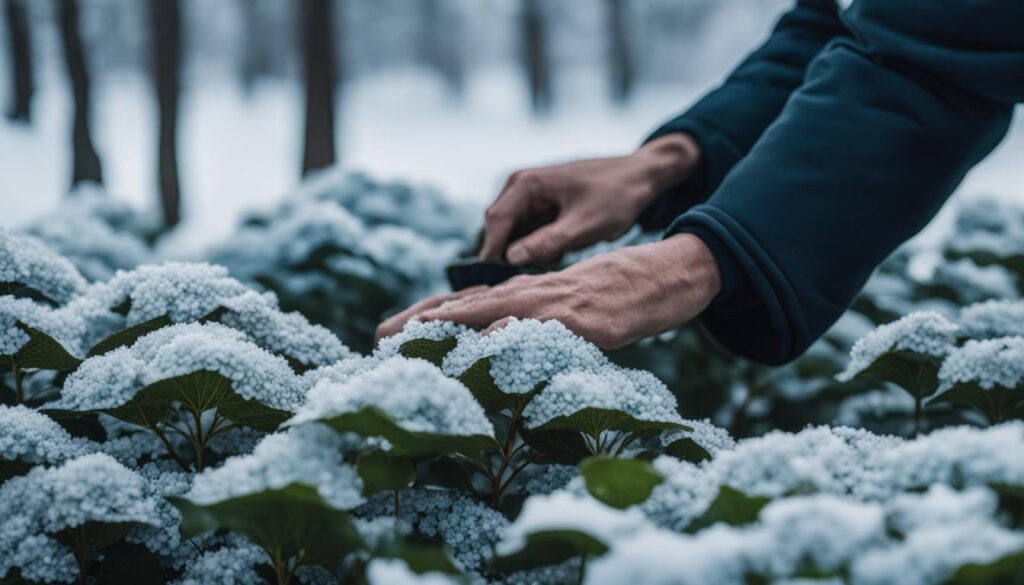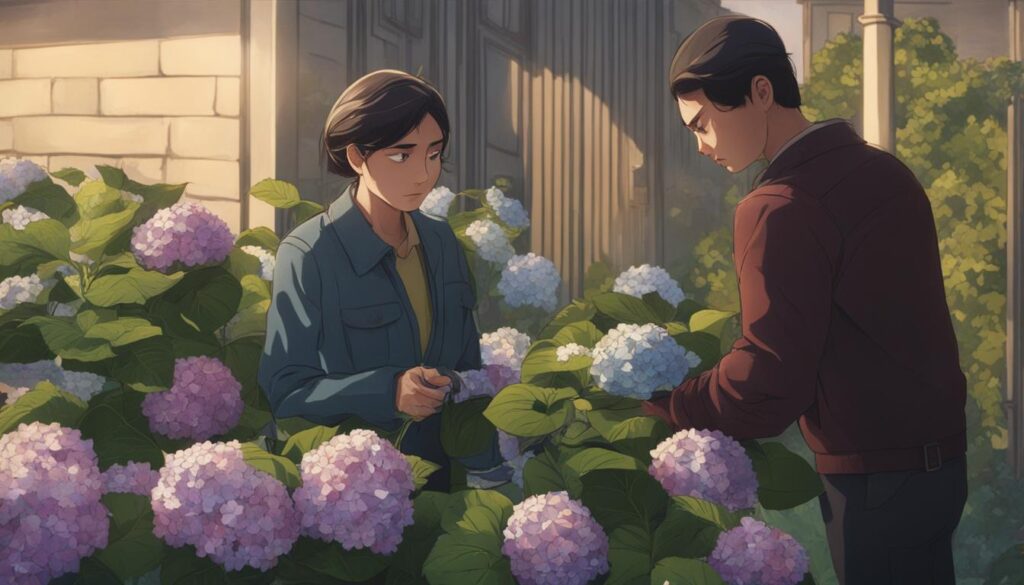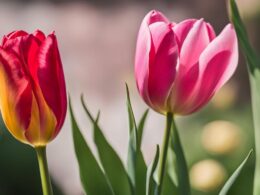If your hydrangea is not blooming, you’re not alone in experiencing this common frustration. Your plant may appear healthy, but it repeatedly shows no flowers on hydrangeas, leaving you puzzled. Fear not – this hydrangea bloom problem can often be resolved. By addressing a few critical factors, you can help your garden flourish with breathtaking hydrangea flowers once again.
Key Takeaways
- Hydrangea bloom problems can have multiple causes, such as incorrect pruning, inadequate winter protection, or improper light conditions.
- Identify the type of hydrangea you have to ensure proper pruning and care.
- Protect your hydrangeas from harsh winter conditions, especially if you live in a colder region like Zone 5 or below.
- Monitor the amount of sunlight your hydrangea receives to encourage healthy blooms.
- Maintain a proper balance of water and fertilizer to provide optimal growing conditions for your hydrangea.
- Take preventive measures to protect your plants from pests like deer or unpredictable weather events, such as sudden frost.
- Addressing the factors listed above increases the likelihood of your hydrangeas blooming beautifully each season.
Understanding the Type of Hydrangea You Own
Recognizing the specific variety of your hydrangea is crucial when trying to solve blooming issues. The four main types are bigleaf hydrangea, oakleaf hydrangea, smooth hydrangea, and panicle hydrangea. Each type has unique bloom patterns and pruning requirements that play a critical role in achieving optimal blooms. In this section, we will guide you in identifying your hydrangea type, understanding the differences in flowering patterns, and determining the best pruning schedule.
Identifying Your Hydrangea: Bigleaf, Oakleaf, Smooth or Panicle
| Type | Botanical Name | Description |
|---|---|---|
| Bigleaf Hydrangea | Hydrangea macrophylla | Known for large, round flower clusters and broad, dark green leaves. Commonly found in shades of blue or pink. |
| Oakleaf Hydrangea | Hydrangea quercifolia | Recognized by its distinctive oak leaf-shaped foliage and cone-shaped flower clusters. It displays stunning fall color. |
| Smooth Hydrangea | Hydrangea arborescens | Features flat, lacecap-like flowers and smaller, heart-shaped leaves. Known for its native, Annabelle, and Incrediball varieties. |
| Panicle Hydrangea | Hydrangea paniculata | Characterized by cone-shaped flower heads and slender, pointed leaves. Popular varieties include Limelight and Vanilla Strawberry. |
Seasonal Bloom Patterns: Old Wood vs. New Wood
Understanding whether your hydrangea blooms on old wood or new wood is crucial in determining the best pruning schedule and avoiding accidental removal of buds. Old wood bloomers include bigleaf and oakleaf hydrangeas, which form flower buds on last season’s growth during late summer and fall. These buds must survive winter to bloom in spring. Conversely, new wood bloomers like smooth and panicle hydrangeas develop their flower buds on the current season’s growth during the spring.
Pruning Schedule: Timing Is Everything
Incorrect pruning is the most common reason for lack of hydrangea blooms. To ensure maximal blooming, follow these pruning guidelines:
- Bigleaf and Oakleaf Hydrangeas: Prune immediately after early summer blooming to avoid removing future flower buds.
- Smooth and Panicle Hydrangeas: Prune in early spring before new growth begins to encourage vigorous development and optimal blooming potential.
By identifying your hydrangea type and adhering to the proper pruning schedule, you will create the ideal conditions for a bountiful floral display.
Combatting Winter Blasts: Protecting Hydrangeas from Cold Damage
When it comes to protecting hydrangeas from cold weather, it’s crucial to take the necessary steps to ensure your plants survive through the winter months. Winter hydrangea care is particularly vital for bigleaf and oakleaf varieties, which are more susceptible to cold damage. Gardeners in colder regions, such as Zone 5 and below, should provide additional winter protection for their hydrangeas.
There are a few key steps to follow for proper hydrangea winter damage prevention. The first is to water your plants deeply before winter arrives. Adequate moisture in the soil will help prevent dry stems and roots, which can lead to more significant damage. In addition, you can create an insulation barrier around the plant to protect it from the worst of the winter cold.
To create an insulation barrier, you can follow these steps:
- Gather materials such as leaves or straw for insulation, as well as burlap or chicken wire for constructing the cylinder.
- Create a cylinder around the plant using the burlap or chicken wire, making sure it stands at least a few inches taller than the plant itself.
- Fill the cylinder with the insulating material of your choice, surrounding the plant fully.
- Secure the top of the cylinder to keep insulation in place, but ensure there is still airflow for the plant.
- Remove the insulation and cylinder in early spring, as temperatures warm up and new growth begins.
Remember, the goal is to protect your hydrangeas from winter damage so they can bounce back and bloom when spring arrives. By taking these necessary precautions, you will ensure your hydrangeas survive the winter months and continue to provide beautiful blooms for you to enjoy.
The Impact of Pruning: Are You Doing It Correctly?
Pruning is an essential aspect of maintaining your hydrangeas’ health and appearance. However, improper hydrangea pruning can lead to a lack of flower production. This section will help you recognize common hydrangea pruning mistakes and guide you through the proper techniques for pruning bigleaf and panicle hydrangeas.
Recognizing Improper Pruning Techniques
Hydrangeas bloom best with minimal pruning. Over-pruning or pruning at the wrong time, such as cutting back during autumn through early spring for old wood bloomers, results in the removal of future flowers. Some common hydrangea pruning mistakes include:
- Cutting back too severely, leaving only a few inches of stems
- Pruning at the wrong time of year, which can remove flower buds
- Not removing dead or damaged branches
- Leaving weak, spindly growth
Guidelines for Pruning Different Hydrangea Varieties
Different hydrangea varieties require specific pruning methods to avoid making mistakes and harming their blooming potential. Below is a table outlining the appropriate pruning times and techniques for various hydrangea types:
| Hydrangea Variety | Pruning Time | Pruning Technique |
|---|---|---|
| Bigleaf (Hydrangea macrophylla) | Immediately after flowering | Remove spent flowers, cut back weak growth, and prune selectively to shape |
| Oakleaf (Hydrangea quercifolia) | Immediately after flowering | Remove spent blooms, trim stems to control size and shape, and eliminate dead or damaged branches |
| Mountain (Hydrangea serrata) | Immediately after flowering | Prune to remove faded flowers, trim the longest stems, and remove damaged branches |
| Climbing (Hydrangea anomala subsp. petiolaris) | Immediately after flowering | Trim back excessively long shoots, remove dead or damaged stems |
| Smooth (Hydrangea arborescens) | Late winter or early spring | Cut back stems to 4-6 inches above ground level, remove dead or damaged wood |
| Panicle (Hydrangea paniculata) | Late winter or early spring | Prune stems back to 1-3 feet, remove dead or damaged branches, and shape if necessary |
| Rebloomers (Endless Summer, Let’s Dance) | As needed | Generally, no regular pruning required; remove dead or damaged branches only |
By understanding the difference in pruning bigleaf hydrangeas and pruning panicle hydrangeas, you can ensure proper care and promote healthy, blooming plants in your garden.
Watering and Fertilizing: Maintaining Proper Soil Conditions
Hydrangeas thrive with ample watering and proper fertilization. To ensure your hydrangeas bloom beautifully, it’s necessary to maintain optimal soil conditions. In this section, we will explore the right ways to water and fertilize your hydrangeas, as well as delve into the importance of the proper soil conditions.
Hydrangea Watering Needs
Hydrangeas require consistent watering, especially during their blooming season. Here are some tips to address your hydrangea watering needs:
- Water your hydrangeas deeply at least once a week, aiming for one inch of water both from rain and irrigation.
- Keep the soil evenly moist during the growing season, but avoid overwatering as this can lead to root rot.
- Use a moisture meter or your finger to gauge the soil moisture level, ensuring it remains consistently damp but not soaked.
- Opt for slow, drip irrigation methods to prevent water wastage and ensure deep penetration
Fertilizing Hydrangeas
Proper nutrition is essential for hydrangea growth and flowering. Here are some guidelines for fertilizing hydrangeas:
- Avoid high nitrogen fertilizers as they promote leaf growth instead of flower development.
- Select fertilizers high in phosphorus to encourage blooming.
- Fertilize hydrangeas once in early spring and again in mid-summer, following the instructions on the fertilizer package.
- Avoid overfertilizing, as this can harm the plant and lead to fewer blooms.
Hydrangea Soil Conditions
It’s essential to maintain optimal soil conditions for hydrangeas, as they are sensitive to changes in soil pH and moisture levels. Consider the following to create an ideal environment:
| Soil Factor | Recommendation |
|---|---|
| Soil pH | Keep the pH in the range of 5.5 to 6.5 for optimal growth. Acidic soil encourages blue flowers, while alkaline soil produces pink blooms. |
| Soil Moisture | Ensure consistent dampness, providing enough water without over-saturating. |
| Soil Composition | Opt for well-draining soil rich in organic matter, such as compost or aged manure. |
By following these guidelines for hydrangea watering, fertilizing, and maintaining proper soil conditions, you’ll be well on your way to enjoying a vibrant and healthy hydrangea garden.
Strategic Sunlight Exposure: Finding the Sweet Spot for Your Hydrangeas
One of the key factors for successful hydrangea blooming is finding the proper balance of sunlight and shade. In this section, you will discover how to assess sunlight in your garden and learn best practices for hydrangea sun and shade requirements.
Assessing Sunlight in Your Garden
Before planting or relocating your hydrangeas, it is essential to perform a garden sunlight assessment to ensure the appropriate balance of sun and shade. The foremost step to conducting this evaluation is to observe and document the sun’s movement in your garden from dawn to dusk. Identify the amount of sunlight exposure each area receives to pick the best location for your hydrangeas.
To gain an accurate understanding of sunlight patterns, make a schedule and record observations during different times of the day, such as early morning, late morning, early afternoon, and late afternoon. Repeat this process for three or four consecutive days, looking for patterns or changes in sunlight exposure.
Best Practices for Hydrangea Sun and Shade Requirements
Hydrangeas generally need a balance of morning sunlight and afternoon shade to prosper and bloom. Specifically, most hydrangea varieties require around 4 to 6 hours of bright morning sun and some protection from harsh afternoon sunlight. However, hydrangea light requirements may vary slightly depending on the specific variety.
Too much shade can result in fewer flowers and elongated stems, while too much direct sunlight may cause scorched leaves and plant stress, thus hindering flower production. To encourage blooming, follow these guidelines:
- Locate hydrangeas in areas receiving bright morning sun and part shade during the afternoon hours.
- Take note of the specific sun exposure requirements for the type of hydrangea you have. Some species, such as the oakleaf hydrangea, can tolerate more sun than others.
- For locations with excessive direct sunlight, provide additional shade protection or consider relocating the plant to a more suitable area.
- Monitor the health of the plant and adjust the location accordingly if you observe signs of stress, such as wilting or scorched leaves.
By understanding and applying these principles of hydrangea light requirements and garden sunlight assessment, you will be better equipped to create the ideal environment for your hydrangeas to grow and thrive, resulting in a bountiful display of beautiful blooms.
Dealing with Pests and Unpredictable Weather Factors
Hydrangeas are often vulnerable to various external threats, such as pests and unpredictable weather conditions. This section offers guidance on protecting hydrangeas from deer and frost prevention for hydrangeas, ensuring your plants can thrive and bloom without hindrance.
Deer, Frost, and Unexpected Freeze: Preventive Measures
Deer are one of the most common pests for hydrangeas, as they find their stems and buds particularly appetizing. To effectively protect your hydrangeas from deer, you can use any of the following methods:
- Install physical barriers, such as fencing or tree guards
- Apply commercial repellent sprays specifically designed for deer
- Place aromatic plants, like garlic and lavender, around hydrangeas to deter deer with their strong scents
Besides deer, frost and unexpected freezing can be detrimental to hydrangea health and blooming. Late spring frosts, in particular, pose a threat to developing buds. To protect your plants from frost, consider implementing these preventative measures:
- Monitor local weather forecasts and be prepared for potential temperature drops
- Use temporary covers, such as blankets or frost cloths, to shield your plants from frost and secure them to the ground to trap warmth
- Choose cold-hardy hydrangea varieties, like panicle and smooth hydrangeas, if your area is prone to late spring frosts
While nature may throw various challenges at your hydrangeas, being proactive and prepared can significantly boost their chances of flourishing and blooming. Keeping deer at bay and being vigilant about frost prevention will contribute to the overall health and vitality of your hydrangea garden.
What Could be the Common Reasons for Flowering Issues in Different Types of Plants?
Troubleshooting hibiscus not flowering can be due to inadequate sunlight, improper watering, or nutrient deficiencies. Different types of plants may also face similar issues, such as lack of pruning, pests, or disease. Understanding the specific needs of each plant can help address flowering problems effectively.
Conclusion
Although it can be disheartening when your hydrangeas are not blooming, it’s important to remember that there are multiple factors that contribute to this common issue. By understanding your hydrangea type, ensuring your pruning practices are timed correctly, providing adequate winter protection, and maintaining proper soil and light conditions, you can ensure hydrangea blooms and cultivate a thriving garden display.
Consistency and attention to detail are fundamental in achieving healthy hydrangea tips, as hydrangeas are susceptible to various environmental challenges, such as pests and harsh weather conditions. Assess your garden’s sunlight exposure and consider relocating your plants if necessary. Additionally, establish prevention methods for deer and frost damage to guarantee the delicate buds remain intact.
In conclusion, cultivating lush hydrangea blooms takes patience, effort, and knowledge of the individual needs of your hydrangea variety. Be proactive in addressing any issues, and enjoy the satisfaction of witnessing a vibrant array of hydrangea flowers gracing your garden each season.











